Have you heard of hoppers? I’d read about them in the Sri Lankan food section of the Lonely Planet, but until our 2014 month in Sri Lanka I’d never seen or tried one. That was because my first trips to Sri Lanka were as a much richer tourist staying in fancy hotels often eating at the more expensive beach restaurants. To get hoppers you needed to go to the local eateries, the roti huts and “hotels” as restaurants in Sri Lanka are often called.
During our 2016 month in Sri Lanka things seemed to have changed gain, the big luxury hotels we used, as well as the villas, had hoppers on the menu. One even had a live cooking station at breakfast producing plain and egg hoppers to order. All had string hoppers and typical curries on the breakfast buffets.
Hoppers are cool these days and tourists seem more willing to try local food, so if you’re heading to Sri Lanka you should now have no problem finding them.
Hoppers were a big winner for us, particularly with the kids. Hoppers come in all sorts of varieties, you’re bound to find the hopper for you.
Hoppers is the anglicised name commonly used in Sri Lanka. Sri Lanka is very anglicised generally. You may also see them on the menu as appam.
Hoppers come in many forms, standard hoppers are the typical bowl shaped pancakes, string hoppers are something very different, keep scrolling down to find out more.
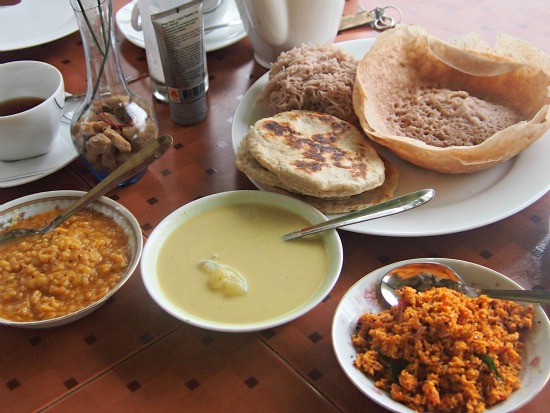
Plain hoppers as part of a delicious Sri Lankan breakfast
Hoppers in their simplest form are bowl-shaped pancakes made from fermented rice flour and coconut milk. Cooked in small round pans, they tend to come out crispy round the edges, thicker at the bottom. They are top right in this photo of a fantastic Sri Lankan breakfast. To eat hoppers you smoosh them with your fingers into the curry and sambol. I believe the technical term for Sri Lankan style eating is smooshing. We became quite good smooshers.
Or you could ask for a knife and fork, nobody will mind.
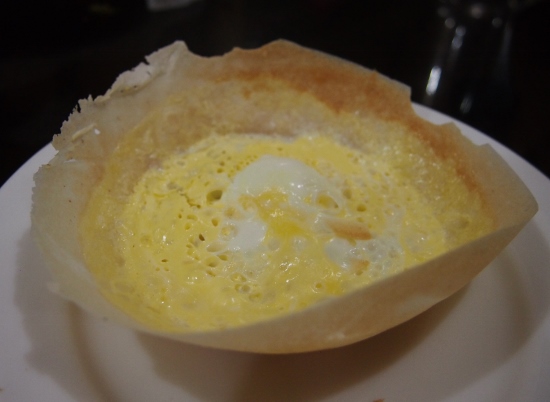
Sri Lankan food, egg hoppers
Egg hoppers are simply a plain hopper with an egg cracked in the bottom. We only really saw these in the evening. Sri Lankan food tends to run to a timetable, you can’t always get the same food all day.
We made this pin for you to bookmark to Pinterest. Thanks.
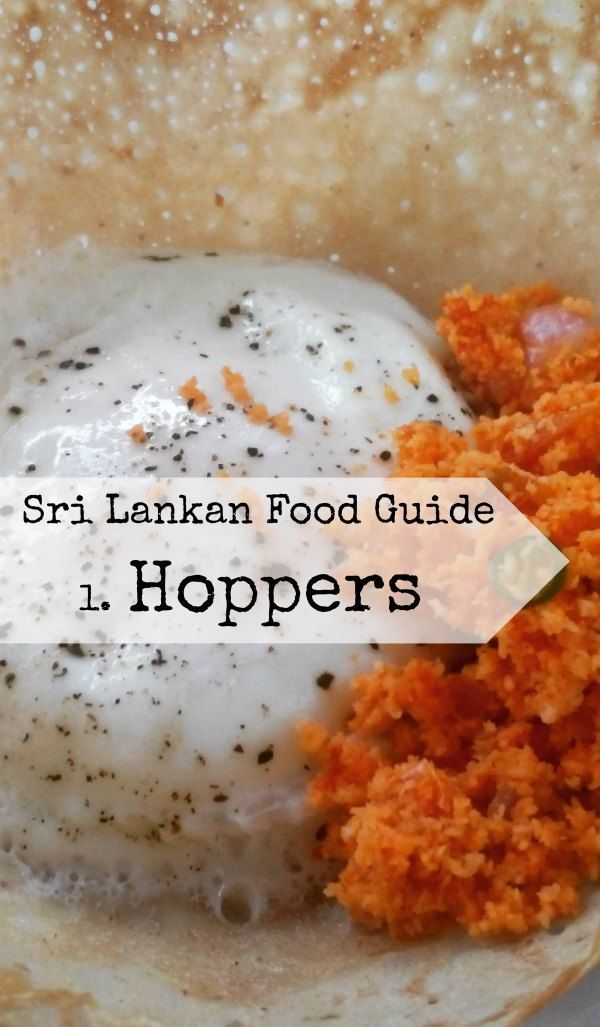
I like my egg hoppers spiced up with some fresh coconut ( pol) sambol as below, the children like theirs with cheese.
Look out for road-side hopper huts with their rows of tiny round pans, take them home or eat in.
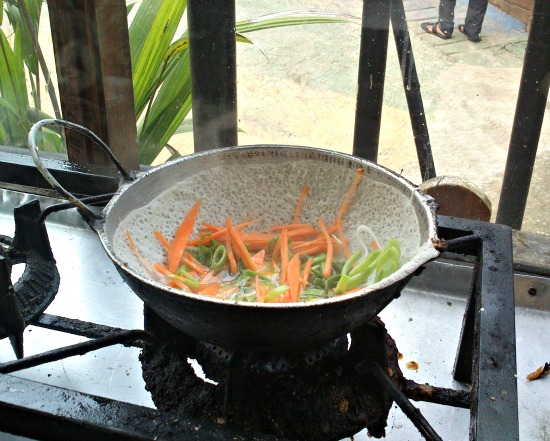
Hopper cooking in Ella . Egg and vegtable.
Hoppers can come with all sorts of fillings
These are vegetable and egg hoppers at The Roti Hut, Ella Sri Lanka. Our favourite place to eat, on the main street in Ella. They cost almost nothing.
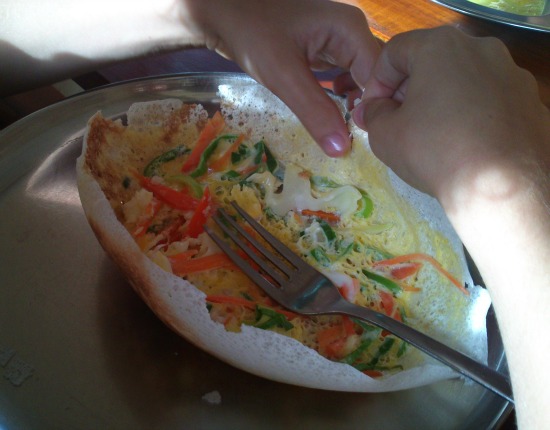
My kids loved Sri Lankan food, particularly hoppers.
The finished dish. I was really happy to feed the boys these hoppers, some good nutrition going on there and nothing spicy.
Cheese and egg hoppers were good, too.
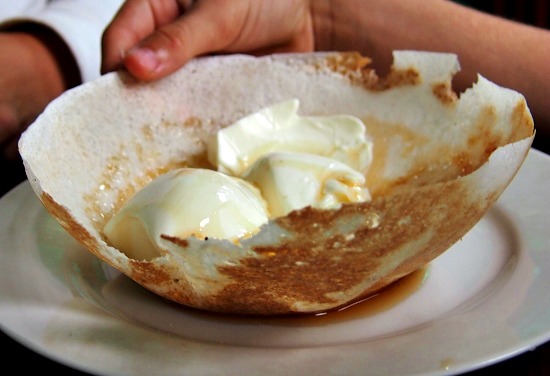
Sri Lankan hoppers can be desert too, here with curd and “trickle”
A special treat. Curd is fresh buffalo yogurt, or sometimes cow. Small road-side stores sell the curd in terracotta pots wrapped in leaves or newspaper all over Sri Lanka. Trickle ( aka treacle or honey) is coconut palm syrup, it has a lovely smokey flavour.
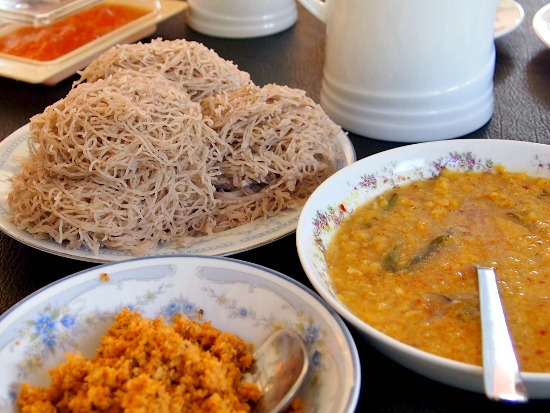
String hoppers, another breakfast time hopper, with dahl and pol sambol.
String hoppers are the things that look like nests of spaghetti in this breakfast picture. To make string hoppers Sri Lankans mix red or white roasted rice flour with water to make a dough, then push it through a sieve or press to make the strands. The little matted nests then go into a steamer.
String hopper makers are widely available in Sri Lanka, in the UK you can buy one on Amazon, ( for USA click here).
.
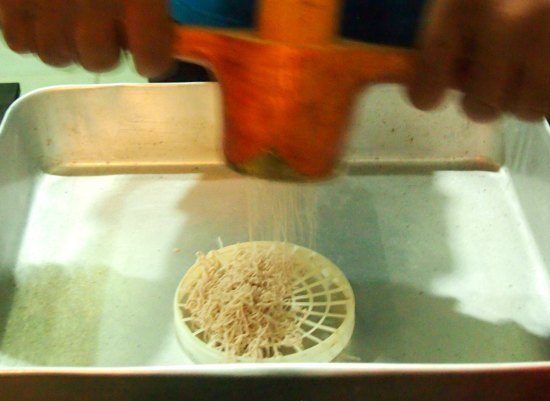
Making string hoppers in Sri Lanka
String hoppers are an essential part of a Sri Lankan breakfast. They are very good for smooshing into the curries and sambols.
String hoppers can also be served with curries at dinner as they were at the luxurious Max Wadiya villa. The private Chef there, Ranjan, gave us a string hopper making master-class (above).
There you go, now you know all about hoppers!
More Sri Lankan food posts to come as part of our complete guide to Sri Lankan food.
Back to our main Family Travel Sri Lanka page.